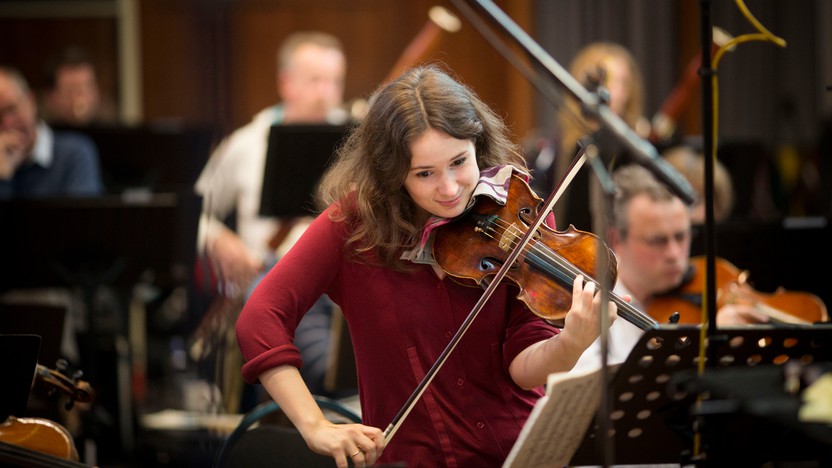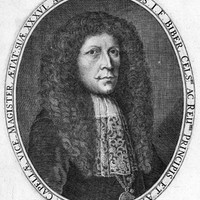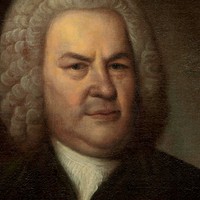Patricia Kopatchinskaja Plays Bach

Sponsored By
- April 16, 2016


Sponsored By


Well before Italians like Arcangelo Corelli and Antonio Vivaldi sparked the violin revolution that brought the Baroque style to its glorious peak after 1700, the Bohemian composer and violinist Heinrich von Biber was developing some of the most exciting and forward-thinking scores ever created from his home base of Salzburg. Even a form as prosaic as mealtime background music brought out Biber’s sense of sonic invention, as heard in the third part of Mensa sonora (“Harmonious Table”), a collection of chamber music dedicated to the Archbishop of Salzburg and published locally in 1680. The opening Gagliarda — the Italian name for the fast French court dance known as the Galliard — makes a game of breaking up the arpeggio of the main theme and bouncing it between instruments. Later, in the Ciacona, rising scale fragments echo between voices as the continuous variations intensify over a cycling bass line.
Biber had a particular knack for the art of musical scene-painting that later obsessed the Romantic composers. One early Serenade in five parts (two violins, two violins and a shared basso continuo line) manifested the nocturnal atmosphere in the most literal way, by incorporating a simple tune sung by a nightwatchman who exhorts the local folk to be on guard as the hour reaches nine and then ten. The accompanying strings play pizzicato throughout, and they return to plucking for echoing passages in the following Gavotte, preserving the atmosphere of eerie quiet.
Biber’s signature composition is his rousing Battalia (Battle) from 1673, scored for nine string instruments and basso continuo. The brief musical vignettes cover everything from the pre-battle bedlam of drunken soldiers singing overlapping songs in clashing keys and tempos to the post-battle “Lament of the Wounded Musketeers.” In between, extended techniques help to simulate military sounds. During a march, for instance, paper placed beneath the strings of a bass makes it sound more like a snare drum accompanying a fife; within the battle itself, the two basses (arranged on opposite sides) use the technique of snap pizzicato to replicate musket fire.
Aaron Grad ©2022

In 1723, Bach was appointed Music Director and Cantor in Leipzig where he taught at the St. Thomas School and directed all musical activities at the city’s two churches, the Thomaskirche and Nikolaikirche. Bach would remain in Leipzig until his death and produced many of his mature masterpieces during his time there. In fulfillment of his church duties in Leipzig, Bach created his greatest sacred works: the cantatas, the Saint Matthew and Saint John Passions, and the Mass in B Minor.
But Bach’s second decade in Leipzig saw the creation of much of his great instrumental music. In 1729, he assumed the directorship of the Collegium Musicum, a concert series presented by local musicians and students, which had been founded in 1702 by Telemann. The Collegium presented weekly concerts for the Leipzig culturati, primarily at the consequently iconic Zimmermann’s Coffeehouse; Bach programmed music by Telemann, Corelli, Vivaldi, and other leading composers of the day, and also composed much new music himself for the series. With the Collegium as a newly available outlet for Bach’s creativity, the 1730s saw a revitalized output of keyboard, chamber, and orchestral music to match the inspired catalogue of sacred vocal music composed over the previous decade.
Bach’s compositional output for the Collegium Musicum included numerous concerti for one, two, three, and four harpsichords, all transcriptions of earlier concertos for wind or string instruments. The Concerto in C Major for three harpsichords, BWV 1064, is Bach’s own transcription of his earlier Concerto in D Major for three violins, now lost. These performances feature this concerto in a scholarly reconstruction of the original, three-violin version.
While they might be heard as identical twins, there is in fact a profound distinction between the two versions: owing to the linear melodic profile of the violin, in contrast with the chordal sonority of the harpsichord, as well as to the likeness of timbre between the solo and orchestral strings, the three-violin version of the Concerto retains the intimacy of chamber music—a character somewhat lost in the grandeur of three harpsichords.
The Concerto is bookended by two affable Allegro movements, the first characterized by a piquant repartee between the three solo violins. In the playful finale, the soloists double, then emerge from, the orchestral strings, creating constantly shifting textures. Between these, Bach weaves an affecting Adagio from sinewy melodic lines, ornamented by delicate trills and curlicues over piercing dissonances.
Patrick Castillo ©2016
I’ve been smitten with the Enesco Octet since the first time I performed it and I am so thrilled to have the opportunity to arrange for the SPCO — with the composer’s consent even! Georges Enesco himself wrote, “This work can be played with a full string orchestra on condition that certain singing parts be entrusted to soloists.” It’s exciting to imagine how we will be sculpting our own version of this vast magnificent work. I can imagine the entire crowd being swept away (performers included) once we reach the rousing Finale!
— © Maureen Nelson
Maureen Nelson ©
Get driving directions and find nearby parking.
Find dining options close to the venue.
View seating charts to find out where you'll be seating.
SPCO concerts are made possible by audience contributions.
For exclusive discounts, behind-the-scenes info, and more:
Sign up for our email club!
